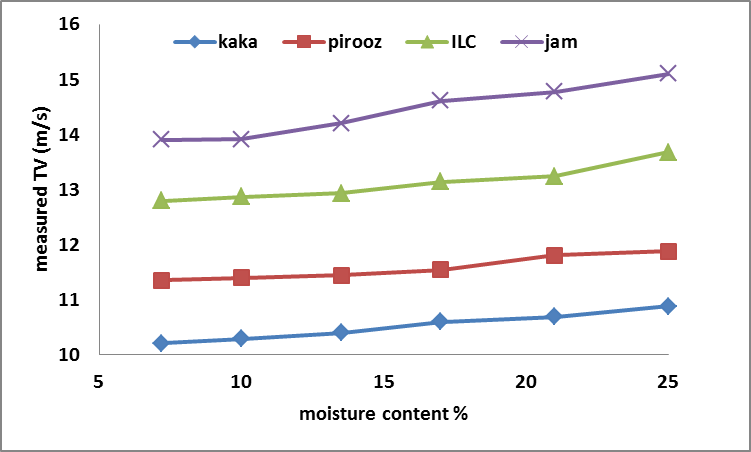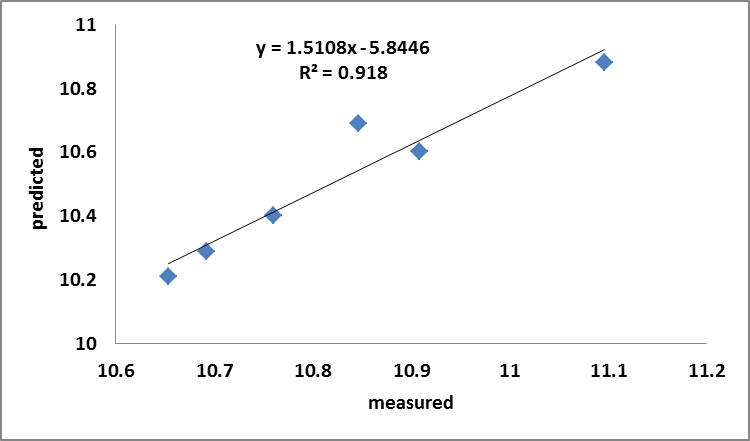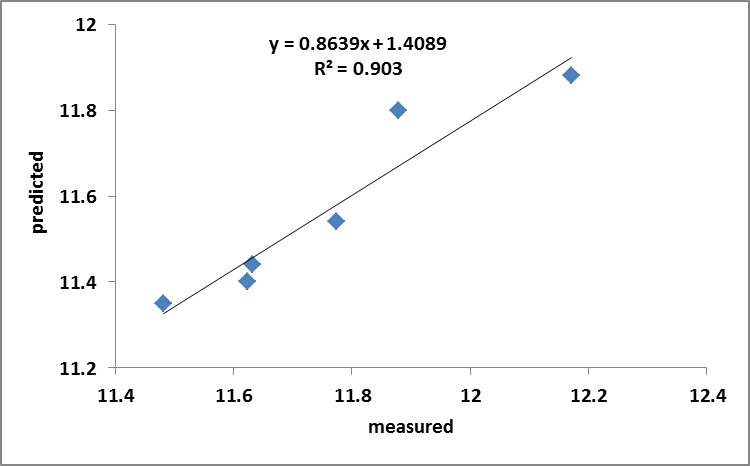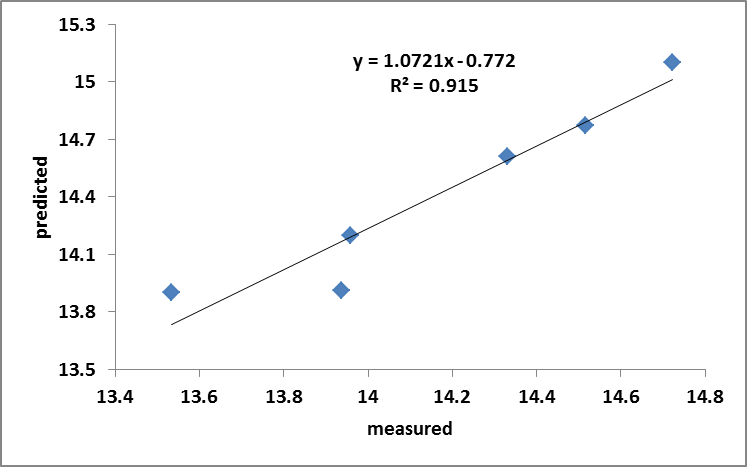Salah Ghamari1, Hadi Goli1, Abdolvahed Khanahmadzadeh1, Khosro Mohammadi2
1Department of Agricultural Machinery, College of agriculture, Sanandaj Branch, Islamic Azad University, Sanandaj, Iran
2Department of Agronomy, College of agriculture, Sanandaj Branch, Islamic Azad University, Sanandaj, Iran
Correspondence to: Salah Ghamari, Department of Agricultural Machinery, College of agriculture, Sanandaj Branch, Islamic Azad University, Sanandaj, Iran.
| Email: |  |
Copyright © 2014 Scientific & Academic Publishing. All Rights Reserved.
Abstract
Terminal velocity of four Iranian varieties of chickpea seeds at six moisture contents levels, experimentally and using mathematical model was obtained. The maximum and minimum values of experimental terminal velocity were obtained for jam and Kaka variety, respectively. The results showed that moisture content have significant effects on terminal velocity in each four varieties. As moisture content increased from around 7 to 25% (w.b.), terminal velocity of jam, ILC, Pirooz and Kaka seeds increased from 13.9 to 15.1, 12.79 to 13.67, 11.35 to 11.88 and 10.21 to 10.88 m/s, respectively. The results also show that suggested mathematical model can be used for prediction the terminal velocity of chickpea varieties, successfully. The coefficients of determination (R2) in predicting terminal velocity for Kaka, Pirooz, ILC and jam varieties were 0.918, 0.903, 0.854 and 0.915, respectively.
Keywords:
Chickpea, Terminal Velocity, Prediction, Moisture Content, Seed Variety
Cite this paper: Salah Ghamari, Hadi Goli, Abdolvahed Khanahmadzadeh, Khosro Mohammadi, Effect of Moisture Content on Terminal Velocity of Chickpea Varieties, International Journal of Agriculture and Forestry, Vol. 4 No. 3A, 2014, pp. 8-11. doi: 10.5923/s.ijaf.201401.03.
1. Introduction
Pulses play an important role in supply the needs of food in human society, especially in the developing countries. Chickpea is one of the most important pulses when considering either its production or consumption. Knowing about the basic engineering properties of this crop is useful in the development of new methods of harvesting and development of new equipment for processing it. Terminal velocity (TV) is one of the most important aerodynamic properties of materials, including seeds of agricultural crop, which is necessary to design of pneumatic conveying systems, fluidized bed dryer and cleaning the product from foreign materials [5].Two different experimentally method for determination of terminal velocity have been studied; in first method (free fall method) by graphing measured height versus time and differentiating at each time, terminal velocity can be obtained. In second method, particle positioned on a screen with controlled airflow, by increasing the airflow in gradual steps, the particle will float in a certain height. The measured air velocity at this height is equivalent to terminal velocity [14]. Many valuable research works have been carried out about terminal velocity of agricultural materials, such as; pistachio nut and its kernel [15], sunflower seeds [7], rice, lentil and chickpea [5], Wheat Kernel and Straw Materials [9], wheat varieties [14], cotton seeds [10], garlic [11], wheat, barely, chickpea and lentil [8]. In other hand, some predicting methods were investigated for terminal velocity of agricultural crops, such as: artificial neural network model for terminal velocity of agricultural seeds [5] and mathematical models for terminal velocity of seeds chickpea, lentil and rice [6].The terminal velocity is affected by the density, shape, size and moisture content of samples [15]. Therefore, it is necessary to determine the aerodynamic properties as a function of different factors such as moisture content and variety. The aim of this research was to obtain terminal velocity of four Iranian varieties of chickpea at six moisture contents levels, experimentally and using mathematical model.
2. Materials and Methods
2.1. Sample Preparation
Four common chickpea varieties called Jam, ILC, Pirooz and Kaka, which are grown in Iran, were prepared from Kurdistan Center for Agricultural and Natural Resources Research. The samples were cleaned manually to remove stones, straw, dirt, broken and damaged seeds.Initial moisture content (MC) of samples was determined by using oven method at 105°C for 24 h [4]. Initial MC of Jam, ILC, Pirooz and Kaka were 7.45, 7.82, 6.95, 7.33% (w.b.), respectively.To obtain samples with higher moisture contents (Table 1), calculated quantity of distilled water was added to the samples. The quantity of distilled water was calculated from the following equation: | (1) |
Where W2 is the mass of distilled water added (kg), W1 is the initial sample mass (kg), M1 and M2 are the initial and desired moisture content of sample (w.b. %), respectively.Then the samples were placed in sealed plastic bags and kept at 4°C in the refrigerator for at least 48 h to enable the moisture to distribute uniformly throughout the sample. Before starting a test, the required quantity of seeds was taken out of the refrigerator and allowed to warm up to room temperature [1, 2, 3].| Table 1. Six moisture content levels of seeds (%) |
| | | 1 | 2 | 3 | 4 | 5 | 6 | | Kaka | 7.45 | 10 | 13.5 | 17 | 21 | 25 | | pirooz | 7.82 | 10 | 13.5 | 17 | 21 | 25 | | ILC | 6.95 | 10 | 13.5 | 17 | 21 | 25 | | jam | 7.33 | 10 | 13.5 | 17 | 21 | 25 |
|
|
2.2. Experimentally Determination of TV
A vertical air tunnel was used to determine experimental terminal velocity. Ten seeds from each variety and moisture content level were randomly selected for measurement of terminal velocity. The seed sample was placed on a mesh screen in vertical tube. The air velocity was adjusted by increasing the speed of motor until the seed began to float. The air velocity near where the seed became suspended was measured with a hot wire system with 0.1 m/s accuracy.
2.3. Prediction TV Using Mathematical Model
In this part of research, the mathematical model suggested by ghamari et al. (2011) was used for predicting TV. This model is based on seed’s shape factor [6]. This model is in the form of equation (2). For using this model, assuming the spherical shape for chickpea seed is necessary.  | (2) |
Where ρ, dg and S is true density (kg/m3), geometric diameter (m) and sphericity factor of seed, respectively. These parameters were measured for seeds, at each variety and each moisture content level. Sphericity factor and geometric diameter of chickpea seeds was measured by using the following equation [12]: | (3) |
 | (4) |
Where L, W and T are length, width and thickness (mm) of seeds, respectively, and were measured by micrometer with 0.02 mm accuracy. True density (g.cm-3) of seeds was measured by water displacement method. For each chickpea variety 10 seeds were weighed using a digital balance with 0.0001 g accuracy, and replaced in water. Mass of water displaced by the seeds was recorded. Finally true densities (g.cm-3) were calculated by using the following equation: | (5) |
where ρt is the true density (g.cm-3), ρw is the water density (1.05 g.cm-3 at laboratory temperature); M and Mw are mass of seeds and water, respectively [13].
3. Results and Discussion
3.1. Effect of Moisture Content on TV
The experimental data for terminal velocity of different varieties of chickpea seeds over the moisture content are shown in Figure 1. It is clear that of the four investigated varieties, jam and Kaka seeds had the largest and lowest amount of TV, respectively. As moisture content increased from 7.33 to 25% (w.b.), TV of jam seeds increased from 13.9 to 15.1 m/s. For the increase in moisture content of ILC seeds from 6.95 to 25%, the increase of TV was 12.79 to 13.67 m/s. TV of Pirooz seeds increased with increase in moisture content (7.82 to 25%) from 11.35 to 11.88 m/s. Finally, as moisture content increased from 7.45 to 25% (w.b.), TV of Kaka seeds increased from 10.21 to 10.88 m/s.  | Figure 1. Measured terminal velocity of chickpea seeds as a function of variety and moisture content |
The change in terminal velocity with moisture content of four investigated chickpea varieties can be represented by the equations shown in Table 2. As this table shows there is linear relationship between TV and moisture content in all varieties. Similar trends were reported for pistachio nut and its kernel [15], wheat varieties [14] and sunflower seeds [7]. | Table 2. Equations representing relationship between TV and moisture content for different varieties of chickpea seeds |
| | variety | Moisture content % | equation | R2 | | Kaka | 7.45-25 | TV = 0.0379 MC + 9.9197 | 0.989 | | pirooz | 7.82-25 | TV = 0.0318 MC + 11.071 | 0.937 | | ILC | 6.95-25 | TV = 0.0461 MC + 12.386 | 0.9178 | | jam | 7.33-25 | TV = 0.0719 MC + 13.292 | 0.9729 |
|
|
3.2. TV Prediction Using Mathematical Model
The average values of geometric mean diameter, true density and sphericity (obtained by equation (3)-(5), necessary for calculation TV using equation (2)), of different varieties of chickpea seeds at different moisture contents are given in Table 3. As this table shows, geometric mean diameter of all varieties increased with increase in moisture content. True density and sphericity had no significant change with moisture content. | Table 3. The average values for geometric mean diameter (dg), sphericity (S) and true density (ρt) of chickpea seeds as a function of moisture content (MC) and variety |
| | variety | MC (%) | dg (mm) | ρt (g.cm-3) | s | | Kaka | 7.45 | 5.8 | 1.02 | 0.7737 | | 10 | 5.85 | 1.019 | 0.7734 | | 13.5 | 5.9 | 1.025 | 0.772 | | 17 | 5.98 | 1.03 | 0.779 | | 21 | 6.06 | 1.018 | 0.769 | | 25 | 6.25 | 1.029 | 0.772 | | pirooz | 7.82 | 6.55 | 1.045 | 0.777 | | 10 | 6.65 | 1.052 | 0.779 | | 13.5 | 6.74 | 1.051 | 0.770 | | 17 | 6.85 | 1.072 | 0.761 | | 21 | 6.93 | 1.065 | 0.771 | | 25 | 7.13 | 1.085 | 0.772 | | ILC | 6.95 | 7.76 | 1.043 | 0.861 | | 10 | 7.82 | 1.038 | 0.829 | | 13.5 | 7.99 | 1.052 | 0.848 | | 17 | 8.2 | 1.032 | 0.857 | | 21 | 8.26 | 1.038 | 0.862 | | 25 | 8.4 | 1.041 | 0.877 | | jam | 7.33 | 8.27 | 1.045 | 0.855 | | 10 | 8.55 | 1.065 | 0.860 | | 13.5 | 8.65 | 1.076 | 0.844 | | 17 | 8.81 | 1.098 | 0.856 | | 21 | 9.08 | 1.075 | 0.870 | | 25 | 9.22 | 1.085 | 0.874 |
|
|
The terminal velocities of chickpea seeds were obtained using equation (2) and resulted data in table (2). Figures (2) to (5) show the coefficient of determination (R2) for mathematical models. The coefficient of determination Kaka, pirooz, ILC and jam varieties were respectively 0.918, 0.903, 0.854 and 0.915.  | Figure 2. Correlation between measured and predicted TV of Kaka variety |
 | Figure 3. Correlation between measured and predicted TV of Pirooz variety |
 | Figure 4. Correlation between measured and predicted TV of ILC variety |
 | Figure 5. Correlation between measured and predicted TV of jam variety |
4. Conclusions
Terminal velocity of four Iranian varieties of chickpea seeds as a function of moisture content were obtained experimentally. The results from this research show that moisture content of seed has a significant effect on terminal velocity of different varieties of chickpea seeds. As moisture content increased from around 7 to 25% (w.b.), TV of jam, ILC, Pirooz and Kaka seeds increased from 13.9 to 15.1, 12.79 to 13.67, 11.35 to 11.88 and 10.21 to 10.88 m/s, respectively. In this research the shape of chickpea seeds was assumed to be spherical, and on the basis of this, the suggested mathematical model was used for predicting TV of them. The results show that this model can be used for prediction the terminal velocity of chickpea varieties, successfully.
References
| [1] | Carman, K., 1996. Some physical properties of lentil seeds, J. Agric. Eng. Res., 5(2), 87-92. |
| [2] | Deshpande, S. D., Bal, S., Ojha, T.P., 1993. Physical properties of soybean, J. Agric. Eng. Res., 56, 89-98. |
| [3] | Dursun E, Dursun, I., 2005. Some physical properties of caper seed. Biosyst. Eng., 92, 237-245. |
| [4] | Esref, I., Hulya, I., 2008. The effect of moisture of organic chickpea grain on the physical and mechanical properties. Int. J. Agric. Res., 3, 40-51. |
| [5] | Ghamari, S., Borghei, A.M., Rabbani, H. Khazaei, J., Basati, F., 2010. Modeling the terminal velocity of agricultural seeds with artificial neural networks. Afr. J. Agr. Res., 5(5), 389-398. |
| [6] | Ghamari, S., Rabbani, H., Khazaei, J., 2011. Mathematical Models for Predicting the Terminal Velocity of Chickpea, Rice and Lentil. World Appl. Sci. J., 15 (11), 1557-1561. |
| [7] | Gupta, R.K., Gopika, A., Sharma, R., 2007. Aerodynamic properties of sunflower seed, J. Food. Eng., 79, 899-904. |
| [8] | Gürsoy, S., Güzel, E., 2010. Determination of Physical Properties of Some Agricultural Grains, Research Journal of Applied Sciences. Eng. Technol., 2, 492-498. |
| [9] | Khoshtaghaza. M., Mehdizadeh, R., 2006. Aerodynamic properties of wheat kernel and straw materials. Agricultural engineering international: the CIGR Ejournal. Manuscript FP 05007. VIII, 1-10. |
| [10] | Kilickan. A., Guner, M., 2006. Pneumatic Conveying Characteristics of Cotton Seeds. Biosyst Eng., 95 (4), 537–546 |
| [11] | Masoumi A.A., Tabil L.G., 2003. Physical properties of chickpea (C. arietinum) cultivars. An ASAE Meeting presentation, Las Vegas, Nevada, 27-30 July, 2003, USA. Paper No: 036058. |
| [12] | Mohsenin, N.N., 1980. Physical properties of plant and animal materials. Gordon and Breach Sci. Publ., New York. |
| [13] | Rafiee, S., Keramat Jahromi, M., Jafari, A., Sharifi, M., Mirasheh, R., Mobli, H., 2007, Determining some physical properties of bergamot (Citrus medica), Int. Agrophys., 21, 293-297 |
| [14] | Rajabipour. A, Tabatabaeefar, A., Farahani, M., 2006. Effect of moisture on terminal velocity of wheat varieties. Int. J. Agr. Eng., 8, 10-13. |
| [15] | Razavi, S.M. A., Rafe, A., Akbari. R., 2007. Terminal velocity of pistachio nut and its kernel as affected by moisture content and variety. Afr. J. Agr. Res., 2 (12), 663-666 |











 Abstract
Abstract Reference
Reference Full-Text PDF
Full-Text PDF Full-text HTML
Full-text HTML